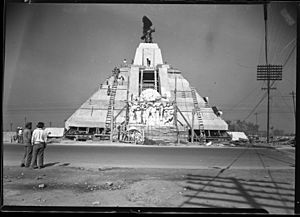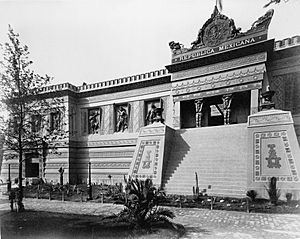Monumento a la Raza (Mexico City) facts for kids

The north side of the monument in 2006
|
|
| Coordinates | 19°27′52″N 99°08′33″W / 19.46444°N 99.14250°W |
|---|---|
| Location | Mexico City, Mexico |
| Designer | Francisco Borbolla (engineer) and Luis Lelo de Larrea (architect) |
| Type | Pyramid |
| Material | Concrete |
| Height | 50 meters (160 ft) |
| Beginning date | 1930 |
| Completion date | 1940 |
| Opening date | 12 October 1940 |
| Dedicated to | La Raza |
The Monumento a la Raza (which means "Monument to the People") is a tall pyramid in northern Mexico City. It stands about 50 meters (160 ft) (164 feet) high. You can find it where three big roads meet: Avenida de los Insurgentes, Circuito Interior, and Calzada Vallejo.
This monument looks like three pyramids stacked on top of each other. It has cool sculptures on its sides and a large eagle statue at the very top. Francisco Borbolla designed the pyramid, and Luis Lelo de Larrea created the stone sculptures. The eagle, made of copper and steel, was sculpted by a French artist named Georges Gardet. The bronze pictures carved into the walls (called high reliefs) were made by Mexican sculptor Jesús Fructuoso Contreras.
The eagle was actually meant for a different building, the Federal Legislative Palace, which was never finished. The reliefs were inspired by an "Aztec Palace" that Mexico showed off at a big fair in Paris in 1889.
Building the monument started in 1930 and took ten years to finish. It opened on October 12, 1940, a day known as Día de la Raza (Columbus Day). The monument is dedicated to la Raza, a term that refers to the indigenous peoples of the Americas and their descendants.
Contents
Why Was the Monument Built?
At the start of the 1900s, Mexico was changing a lot. After a long period of rule by President Porfirio Díaz, the Mexican Revolution began in 1910. This revolution changed how the government saw its people. Before, the government focused on modernizing the country, which sometimes overlooked the needs of indigenous people.
After the revolution, a new idea called indigenismo became popular. This idea celebrated the rich history and culture of Latin America's indigenous people. It aimed to honor their importance in the country's identity.
What Does "La Raza" Mean?
The monument is named after la Raza. This Spanish term literally means "the race," but in this context, it means "the people." It refers to the indigenous peoples of the Americas and their descendants.
So, the Monumento a la Raza is a tribute to these important groups of people. It is also known as the "Monument to the People" or "La Raza Monument."
Building the Monument
The construction of the Monumento a la Raza began in 1930. The Mexican government supported this big project. Engineer Francisco Borbolla and architect Luis Lelo de Larrea led the design. Borbolla wanted the monument to show Mexico's long history.
The monument was finished in 1940. It was officially opened on October 12, 1940, which is Día de la Raza.
Where is the Monument?
The monument is located in the middle of Avenida de los Insurgentes. It's close to Circuito Interior and Calzada Vallejo. This area is in the San Simón Tolnáhuac neighborhood of the Cuauhtémoc borough.
You can visit the monument every day from 12 p.m. to 8 p.m. Sometimes, access might be temporarily closed, like it was during the COVID-19 pandemic in Mexico.
What Does the Monument Look Like?
The Monumento a la Raza is a 50 meters (160 ft) tall pyramid. It is made of concrete and has three pyramid shapes stacked on top of each other. Each of its four sides has smooth, sloped walls. These walls are decorated with carvings (reliefs) that look like the Feathered Serpent from the ancient city of Xochicalco.
The large eagle sculpture on top sits on a special base. It is made of copper and steel. The eagle's wings are spread wide, measuring 5.75 meters (18.9 ft) (18.9 feet) across. It stands on a nopal cactus and is shown eating a snake that is 5.30 meters (17.4 ft) (17.4 feet) long. This eagle was designed by Georges Gardet for a different building, the Federal Legislative Palace. That palace was never completed, and later the Monumento a la Revolución was built instead.
On each side of the pyramid's top part, there is a large bronze carving (high relief) made by Jesús Fructuoso Contreras. These carvings show important ancient rulers:
- Itzcoatl (1380–1440), a ruler of Tenochtitlan.
- Nezahualcoyotl (1402–1472), a ruler of Texcoco.
- Totoquihuatzin (early 16th century), a ruler of Tlacopan.
- Cuauhtémoc (around 1497–1525), the last Aztec Emperor.
Contreras originally made these sculptures for the Aztec Palace. This palace was part of Mexico's display at the 1889 Paris Exposition.
At the bottom of the monument, there are two staircases. The south staircase leads to the top of the monument. The north staircase leads to the main entrance. At the start of each staircase, you can see sculptures of serpent heads, inspired by the ancient city of Tenochtitlan. On the other sides, there are two more sculptures by Lelo de Larrea: Grupo de la fundación de México (Group of the Founding of Mexico) on the east side and Grupo defensa de Tenochtitlán (Group of the Defense of Tenochtitlan) on the west side.
Images for kids
-
A bronze casting of Itzcoatl (north side)
See also
 In Spanish: Monumento a La Raza para niños
In Spanish: Monumento a La Raza para niños










